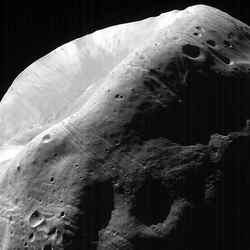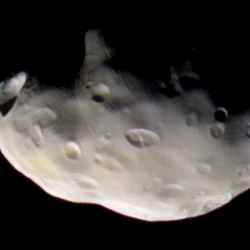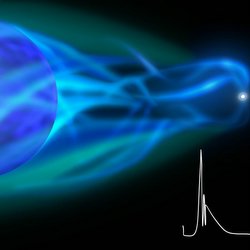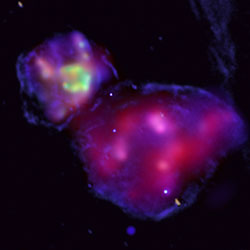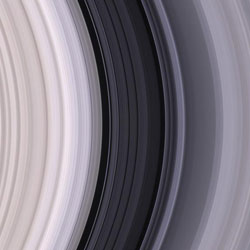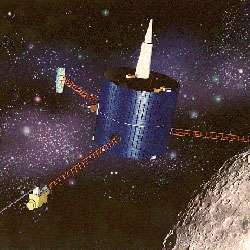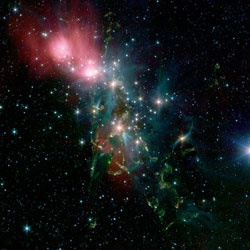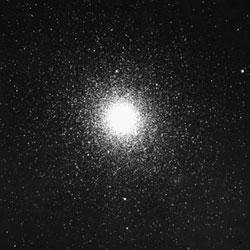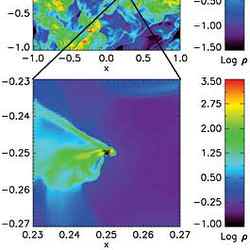
A slice through a 3-D simulation of a turbulent clump of molecular hydrogen. Image credit: Mark Krumholz. Click to enlarge
Astrophysicists at the University of California, Berkeley, and Lawrence Livermore National Laboratory (LLNL) have exploded one of two competing theories about how stars form inside immense clouds of interstellar gas.
That model, which is less than 10 years old and is championed by some British astronomers, predicts that interstellar hydrogen clouds develop clumps in which several small cores – the seeds of future stars – form. These cores, less than a light year across, collapse under their own gravity and compete for gas in the surrounding clump, often gaining 10 to 100 times their original mass from the clump.
The alternative model, often termed the “gravitational collapse and fragmentation” theory, also presumes that clouds develop clumps in which proto-stellar cores form. But in this theory, the cores are large and, though they may fragment into smaller pieces to form binary or multiple star systems, contain nearly all the mass they ever will.
“In competitive accretion, the cores are seeds that grow to become stars; in our picture, the cores turn into the stars,” explained Chris McKee, professor of physics and of astronomy at UC Berkeley. “The observations to date, which focus primarily on regions of low-mass star formation, like the sun, are consistent with our model and inconsistent with theirs.”
“Competitive accretion is the big theory of star formation in Europe, and we now think it’s a dead theory,” added Richard Klein, an adjunct professor of astronomy at UC Berkeley and a researcher at LLNL.
Mark R. Krumholz, now a post-doctoral fellow at Princeton University, McKee and Klein report their findings in the Nov. 17 issue of Nature.
Both theories try to explain how stars form in cold clouds of molecular hydrogen, perhaps 100 light years across and containing 100,000 times the mass of our sun. Such clouds have been photographed in brilliant color by the Hubble and Spitzer space telescopes, yet the dynamics of a cloud’s collapse into one or many stars is far from clear. A theory of star formation is critical to understanding how galaxies and clusters of galaxies form, McKee said.
“Star formation is a very rich problem, involving questions such as how stars like the sun formed, why a very large number of stars are in binary star systems, and how stars ten to a hundred times the mass of the sun form,” he said. “The more massive stars are important because, when they explode in a supernova, they produce most of the heavy elements we see in the material around us.”
The competitive accretion model was hatched in the late 1990s in response to problems with the gravitational collapse model, which seemed to have trouble explaining how large stars form. In particular, the theory couldn’t explain why the intense radiation from a large protostar doesn’t just blow off the star’s outer layers and prevent it from growing larger, even though astronomers have discovered stars that are 100 times the mass of the sun.
While theorists, among them McKee, Klein and Krumholz, have advanced the gravitational collapse theory farther toward explaining this problem, the competitive accretion theory has come increasingly into conflict with observations. For example, the accretion theory predicts that brown dwarfs, which are failed stars, are thrown out of clumps and lose their encircling disks of gas and dust. In the past year, however, numerous brown dwarfs have been found with planetary disks.
“Competitive accretion theorists have ignored these observations,” Klein said. “The ultimate test of any theory is how well it agrees with observation, and here the gravitational collapse theory appears to be the clear winner.”
The model used by Krumholz, McKee and Klein is a supercomputer simulation of the complicated dynamics of gas inside a swirling, turbulent cloud of molecular hydrogen as it accretes onto a star. Theirs is the first study of the effects of turbulence on the rate at which a star accretes matter as it moves through a gas cloud, and it demolishes the “competitive accretion” theory.
Employing 256 parallel processors at the San Diego Supercomputer Center at UC San Diego, they ran their model for nearly two weeks to show that it accurately represented star formation dynamics.
“For six months, we worked on very, very detailed, high-resolution simulations to develop that theory,” Klein said. “Then, having that theory in hand, we applied it to star forming regions with the properties that one could glean from a star forming region.”
The models, which also were run on supercomputers at Lawrence Berkeley National Laboratory and LLNL, showed that turbulence in the core and surrounding clump would prevent accretion from adding much mass to a protostar.
“We have shown that, because of turbulence, a star cannot efficiently accrete much more mass from the surrounding clump,” Klein said. “In our theory, once a core collapses and fragments, that star basically has all the mass it is ever going to have. If it was born in a low-mass core, it will end up being a low-mass star. If it’s born in a high mass core, it may become a high-mass star.”
McKee noted that the researchers’ supercomputer simulation indicates competitive accretion may work well for small clouds with very little turbulence, but these rarely, if ever, occur and have not been observed to date. Real star formation regions have much more turbulence than assumed in the accretion model, and the turbulence does not quickly decay, as that model presumes. Some unknown processes, perhaps matter flowing out of protostars, keep the gases roiled up so that the core does not collapse quickly.
“Turbulence opposes gravity; without it, a molecular cloud would collapse far more rapidly than observed,” Klein said. “Both theories assume turbulence is there. The key is (that) there are processes going on as stars begin to form that keep turbulence alive and prevent it from decaying. The competitive accretion model doesn’t have any way to put this into the calculations, which means they’re not modeling real star forming regions.”
Klein, McKee and Krumholz continue to refine their model to explain how radiation from large protostars escapes without blowing away all the infalling gas. For example, they have shown that some of the radiation can escape through cavities created by the jets observed to come out the poles of many stars in formation. Many predictions of the theory may be answered by new and larger telescopes now under construction, in particular the sensitive, high-resolution ALMA telescope being constructed in Chile by a consortium of United States, European and Japanese astronomers, McKee said.
The work was supported by the National Aeronautics and Space Administration, the National Science Foundation and the Department of Energy.
Original Source: UC Berkeley News Release

